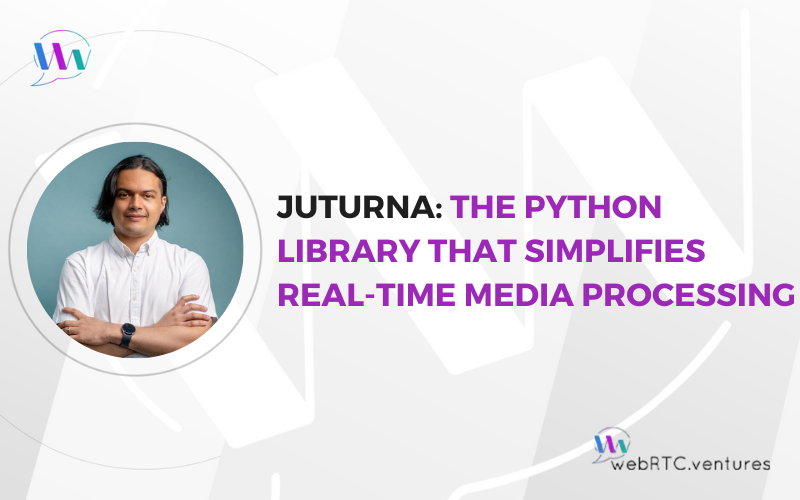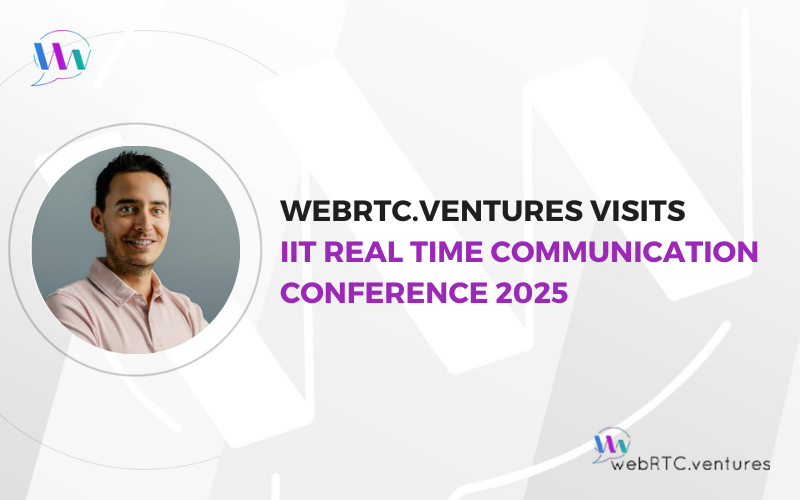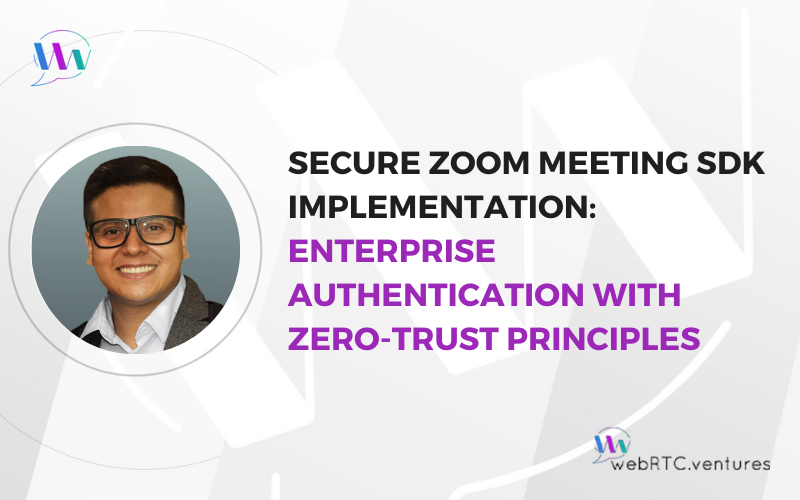December 3, 2025
Jen Oppenheimer
Comments Off on Five WebRTC Predictions for 2026: Tsahi Levent-Levi on AV1, MOQ, and What Might Break Next
Five WebRTC Predictions for 2026: Tsahi Levent-Levi on AV1, MOQ, and What Might Break Next
Each month, our CEO Arin Sime sits down with long-time WebRTC industry authority Tsahi Levent‑Levi of BlogGeek.me to discuss the latest real-time communications trends and challenges. In their November 2025 session, Arin asked Tsahi five pointed questions and gave him 90 seconds per answer, pushing for clear calls on where real‑time video is heading in the next year and beyond. In this post, you’ll get a readable summary of those five predictions, including: Whether developers
December 2, 2025
Hector Zelaya
Comments Off on How to Choose Voice AI Agent Patterns: Conversation-based vs Turn-based Design
How to Choose Voice AI Agent Patterns: Conversation-based vs Turn-based Design
The choice between conversation-based and turn-based Voice AI agent patterns is a strategic business decision, not just a technical detail. Beyond what your agent will say, you must decide how it will run. This architectural choice defines how your voicebot will scale, what it will cost to operate, and how your customers will experience it. There are two primary patterns for deploying a Voice AI agent: Conversation-based (Isolated Process): A stateful, dedicated "concierge" for each
November 19, 2025
Hector Zelaya
Comments Off on How Client-Side WebRTC Monitoring Improves Telehealth Video Quality
How Client-Side WebRTC Monitoring Improves Telehealth Video Quality
For the third time, the video froze mid-sentence. The patient, trying to describe a worrying symptom, could only see a static image of her doctor. The promise of convenient, accessible healthcare was quickly turning into a frustrating, stressful experience for both parties. This scenario is an all-too-common nightmare for telehealth platforms. And chances are, while this call was failing, your server health dashboard was a sea of green. This is the telehealth monitoring gap. Traditional
November 19, 2025
Jen Oppenheimer
Comments Off on Watch WebRTC Live #107: MOQ vs. WebRTC: A Panel Discussion with Cloudflare
Watch WebRTC Live #107: MOQ vs. WebRTC: A Panel Discussion with Cloudflare
On the November 19 episode of WebRTC Live, we attempted to settle the debate on “MOQ vs. WebRTC” once and for all. Since Cloudflare has been expanding its offerings in 2025, with both WebRTC- and MOQ-related product announcements, we invited a few members of their team for a MOQ debate (pun intended) and to get their take on the best use cases for WebRTC, MOQ, and a DASH of HLS (also intended). Panel host: Arin Sime,
November 6, 2025
Hector Zelaya
Comments Off on How to Integrate the WhatsApp Business Calling API with WebRTC to Enable Customer Voice Calls
How to Integrate the WhatsApp Business Calling API with WebRTC to Enable Customer Voice Calls
Until recently, enabling real-time voice calls between your business applications and WhatsApp’s 3+ billion users required complex telecom infrastructure. The WhatsApp Business Calling API, introduced by Meta in July 2025, changes that by letting businesses integrate voice calls directly into WhatsApp conversations using VoIP (Voice over Internet Protocol) and WebRTC. This Voice API unlocks transformative customer experiences within WhatsApp, such as: AI-powered conversational agents that can speak with customers. One-touch telehealth consultations directly within a
October 31, 2025
Hector Zelaya
Comments Off on Juturna: The Python Library That Simplifies Real-Time Media Processing
Juturna: The Python Library That Simplifies Real-Time Media Processing
As WebRTC developers, we've gotten very good at moving real-time media around the globe. But often, the most exciting and valuable work happens when we stop just routing media and add some processing to it. The challenge is that building custom, real-time media processing workflows is often complex, requiring deep expertise and significant engineering effort. That's why we were thrilled to see the announcement of Juturna, a new open-source library from the brilliant minds at
October 22, 2025
Jen Oppenheimer
Comments Off on Watch WebRTC Live #106: Rearchitecting Your WebRTC App and the Power of Voice AI Agents for Telephony
Watch WebRTC Live #106: Rearchitecting Your WebRTC App and the Power of Voice AI Agents for Telephony
Many WebRTC applications struggle with outdated or inappropriate media server infrastructure, limiting their ability to scale effectively and support powerful AI features. Alfred Gonzalez, Senior WebRTC Engineer at WebRTC.ventures, walks us through the considerations, options, and steps to successfully migrate to another media server. He’ll then show how this rearchitecting opens the door to implement AI-powered voice assistants using STT, TTS, and LLM services to intelligently handle inbound customer calls. Alfred will also demonstrate how
October 22, 2025
Alberto Gonzalez
Comments Off on Building Layered AI Customer Service Architectures: When Rules, SLMs, and LLMs Work Together
Building Layered AI Customer Service Architectures: When Rules, SLMs, and LLMs Work Together
When Sam Altman called GPT‑5 “a PhD in every discipline in your pocket,” it captured the awe surrounding modern large language models. As builders, we should be thrilled. This is an extraordinary leap in what’s technically possible. But here’s my unpopular opinion: just because we can use the most massive LLM for every task doesn’t mean we should. In customer service AI, bigger isn’t always better. The real challenge is architectural—matching each task with the
October 21, 2025
Hector Zelaya
Comments Off on MOQ Protocol Explained: Unifying Real-Time and Scalable Streaming
MOQ Protocol Explained: Unifying Real-Time and Scalable Streaming
Digital media delivery today relies on two powerful but separate approaches: scalable streaming and real-time conversation. Each one excels at a specific purpose, and understanding both reveals why MOQ represents a fundamental shift in how we may be building these applications in the future. Let's explore what makes the current landscape so divided, how MOQ aims to deliver a latency-tunable approach, and why this matters for anyone building media applications today. Current Media Delivery: HLS/DASH
A Senior WebRTC Engineer’s Take on RTC.ON 2025
Last year, I attended the RTC.ON conference organized by Software Mansion for the first time. I shared my take on the conference in this WebRTC.ventures blog post: A WebRTC Developer’s Take on RTC.ON 2024. I also spoke at the 2024 conference, a recording of that talk is available on YouTube: Boosting Inclusivity: Closed Captioning & Translations in WebRTC. I loved the conference and was excited to come again. This time I was only a participant,
October 14, 2025
Hector Zelaya
Comments Off on Slow Voicebot? How to Fix Latency in Voice-Enabled Conversational AI Systems
Slow Voicebot? How to Fix Latency in Voice-Enabled Conversational AI Systems
Voicebot latency is the most critical performance metric for voice-enabled Conversational AI systems. While text-based interactions can tolerate response delays of several seconds, voice agents must respond as quickly as possible to maintain natural dialogue flow. Even slight delays create slow voicebots with perceptible awkwardness that degrades user experience and erodes trust in the system. The challenge stems from Conversational Voice AI's inherent architectural complexity. Voice-enabled agents often coordinate multiple AI technologies—speech recognition, language processing,
October 8, 2025
Alberto Gonzalez
Comments Off on WebRTC.ventures Visits IIT Real Time Communication Conference 2025
WebRTC.ventures Visits IIT Real Time Communication Conference 2025
Earlier this week, I had the privilege to travel back to my alma mater, the Illinois Institute of Technology in Chicago, to speak at and attend the IEEE RTC Conference & Expo 2025, which covered WebRTC, Mobility, VoIP, and Next Generation 911. This annual event continues to be one of the leading gatherings for innovators, researchers, and practitioners shaping the future of real-time communication systems. It was a great opportunity to reconnect with colleagues across
October 7, 2025
Hector Zelaya
Comments Off on How Much Does It Really Cost to Build and Run a WebRTC Application?
How Much Does It Really Cost to Build and Run a WebRTC Application?
WebRTC’s code may be open source and royalty-free, but deploying a reliable, production-grade real-time communications application involves both up-front development investment (engineering, integration, and setup) and ongoing operational spending (infrastructure, bandwidth, monitoring, and scaling). Teams who overlook either side risk major surprises as their product grows. So how much does building and running a WebRTC application cost? The answer varies widely depending on your approach and your usage. Building your own solution (DIY) versus using
October 6, 2025
Jen Oppenheimer
Comments Off on Why WebRTC Is the Best Transport for Real-Time Voice AI Architectures
Why WebRTC Is the Best Transport for Real-Time Voice AI Architectures
Voice AI applications need real-time and reliable audio communication for natural conversations with AI customer service bots, virtual assistants, IVR platforms, and other voice-enabled systems. Choosing the appropriate transport protocol is crucial for teams, as using the wrong one can lead to choppy audio, noticeable delays, and dropped connections. To support realistic conversational AI, the transport protocol must handle variable network conditions, secure media transport, and deliver high-quality audio with minimal latency. In this post,
How to Get Started with WebRTC
WebRTC has been enabling video and audio communication directly in your browser without any plugins for 10 years now. Even services like Google Meet and Discord use WebRTC to provide crystal-clear voice and video calls in real-time. This powerful technology has revolutionized how we connect online, but getting started with it can seem daunting. In this WebRTC tutorial, we will break down the core WebRTC concepts, show you how communication is established, and outline what
WebRTC.ventures Visits RTC.ON 2025
Last week I attended the RTC.ON 2025 conference in Krakow, Poland, alongside my colleagues Alberto González Trastoy and Alfred González Trastoy from our WebRTC.ventures team. The conference is in its third year, and this was my second time attending. RTC.ON has quickly become one of the premier gatherings for video and voice developers. It’s always a fantastic opportunity to learn, share ideas, and connect with peers who are pushing the boundaries of real-time communication. This
Integrating Telephony into Telehealth Solutions
There's one important catch to telehealth: not everyone has reliable internet access, and connectivity can fail at any point during remote medical appointments, even in regions with strong coverage. Telephony integration using traditional voice networks remains a vital backup solution when digital connections drop during virtual healthcare visits. This technology connects conventional phone systems with modern telehealth platforms, ensuring appointments can be completed whether patients are using smartphones with spotty data coverage or landlines in
Watch WebRTC Live #105: Live from RTC.ON 2025
Host Arin Sime was live from the RTC.ON 2025 conference in Krakow, Poland, with short discussions with three of the event speakers: Will Law, Chief Architect / Akamai. Conference presentation: A QUIC update on MOQ and WebTransport Cezary Siwek, Staff Engineer / Stream. Conference presentation: Challenges in Realtime livestreaming at 4k / 60FPS Christoph Guttandin, Developer / Media Codings. Conference presentation: Designing a media container library for the web Read our conference wrap up: WebRTC.ventures Visits RTC.ON
September 17, 2025
Juan de la Roca
Comments Off on Secure Zoom Meeting SDK Implementation: Enterprise Authentication with Zero-Trust Principles
Secure Zoom Meeting SDK Implementation: Enterprise Authentication with Zero-Trust Principles
Enterprise video SDK integrations frequently expose critical security vulnerabilities. Client-side secrets, unvalidated webhooks, and bypassed authentication layers create attack vectors that persist in production systems. These implementations typically function correctly during development, but fail security audits and present significant risks in enterprise environments. We've built a real-time video platform architecture that addresses these fundamental security gaps. The implementation uses the Zoom Meeting SDK as the video foundation, chosen for its comprehensive enterprise feature set, embedded
September 16, 2025
Jen Oppenheimer
Comments Off on Beyond WebRTC Projects: Build Your Complete Engineering Team
Beyond WebRTC Projects: Build Your Complete Engineering Team
If you're in the RTC community, you know that WebRTC.ventures excels at assessing, building, testing, and managing real-time communication applications. But what happens when your success leads to bigger ambitions? When you need full engineering teams, not just project-based development? When you're ready to scale beyond individual applications to building comprehensive development capabilities? This is where AgilityFeat, our parent company, comes in. From WebRTC Success to Strategic Scaling You’ve reached a pivotal moment. Your application


























